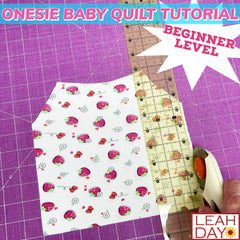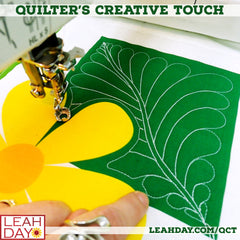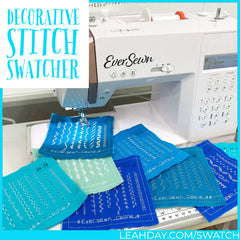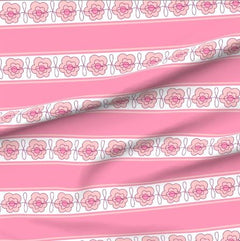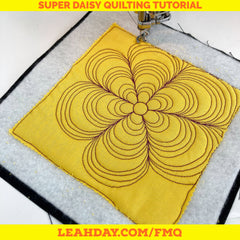I'm so excited to share this quilting tutorial on one of my favorite machine quilting designs. Matrix is quilted with gentle curving lines that overlap to create a flowing grid on your quilt. This is the perfect design to secure the layers of a quilt together quickly, but you can also quilt it densely to create a unique grid effect.
Learn how to quilt Matrix in this new walking foot quilting tutorial:
Click Here to find the book Explore Walking Foot Quilting with Leah Day. Inside you'll find 30 fun walking foot quilting designs with tips on how to use them in real quilts. This book also includes the quilt pattern for Marvelous Mosaic, the quilt we're making together with these squares!
We're quilting all the squares for Marvelous Mosaic, and then we will trim them down and connect them together to create the finished quilt. This style of quilting is called Quilt-As-You-Go and it makes quilting big quilts much easier on your home machine.
Tips for Quilting Matrix with Walking Foot Quilting

The key to quilting Matrix with your walking foot is also the key to quilting curving lines: keep the curves gentle. Shallow curves are much easier to quilt and require less stopping to rotate and re-position the quilt.
 When the lines are close together, you can echo one curving line using the edge of your walking foot or a guide bar set up to the back. I used a guide bar on my walking foot to space the lines 1 inch apart consistently through the quilt square.
When the lines are close together, you can echo one curving line using the edge of your walking foot or a guide bar set up to the back. I used a guide bar on my walking foot to space the lines 1 inch apart consistently through the quilt square.
If you want to stitch your quilt faster, simply increase the distance between these lines of quilting. Depending on your guide bar, you could leave 2-3 inches of your quilt open and this would significantly reduce the number of lines you're quilting and how much time it takes to quilt your quilt.
In the other direction, if you have a small space to quilt and you want the design to really stand out, try quilting Matrix on a smaller scale. The more lines of quilting in the space, the more time it will take, and the stiffer your quilt will feel, but it will look super pretty!
How much quilting does your quilt need? That all depends on your quilt batting in the middle. Learn more about picking the best batting for any quilt project in the Basting Basics Workshop.
Just a quick reminder about my machine settings:
For walking foot quilting I always set the stitch length to 1.5 mm and place a Queen Supreme Slider on my sewing table to the left of the feed dogs like so:
However, for this Marvelous Mosaic Quilt, I have Minky fabric on the back which likes to grip the machine and table. When using this fabric on the back, I increase the stitch length to 2.5 mm.
What's that weird thing on top of my machine? That's a small magnetic pincushion and a cheater needle. I keep those handy for tying off and burying loose thread tails as I quilt. Click Here to check them out.
Free Motion Quilting or Walking Foot Quilting?

There are several types different types of machine quilting. In the video above, I was quilting with a walking foot and using the feed dogs and the foot to guide the quilt through the machine. I like taking my hands off the quilt while I'm stitching to show you that it will move all by itself. My hands are only on the quilt to steer it into the gentle curve.
But there's another type of quilting called Free Motion Quilting where you use a darning foot and steer the quilt yourself to make the design. In this case, you're controlling the stitch length, forming the design, and spacing the lines all by yourself. If you take your hands off the quilt when free motion quilting, the quilt won't move because you're not using the feed dogs on the machine. Learn more about feed dogs here.

The upside of free motion quilting is it's faster. You can stitch deep curves with free motion quilting and you don't have to rotate the quilt a bit. Because this style of quilting isn't dependent on the feed dogs, you can shift the quilt in any direction and have less bulk in the arm of the sewing machine.
But as you can see in the image above, the lines may not be as perfectly aligned or the stitches 100% consistent. When free motion quilting, you won't have the nice guide bar or a chunky foot to line up with your stitching. You have to eyeball everything with free motion quilting and that's a skill that takes time and practice to master.
Learn how to quilt Matrix with free motion quilting in this quilting tutorial:
Whoa! You can quilt the same design two different ways? But which way is best?
Unfortunately the answer is - it depends. It depends on how comfortable you are with either style of quilting. If you like the machine feeding the fabric for you, walking foot quilting will be a better choice.
If you want to quilt Matrix and make the lines crazy curvy, then you should try free motion quilting. There isn't a right or wrong, best or worse style of quilting. Each type of quilting has upsides and downsides, trade offs and bonuses.
The best thing to do is try quilting Matrix with both types of machine quilting and see which works best for you!
Would you like to learn new machine quilting designs and make a big, beautiful quilt?
That's what we're making with Marvelous Mosaic!
We're quilting all 30 designs from the book Explore Walking Foot Quilting with Leah Day and we're going to connect together the best 20 to create the Marvelous Mosaic Quilt.
Click Here to find all the walking foot quilting videos I've shared so far. We're making three quilts together from this book and you can join in the fun and follow along anytime!
Let's go quilt,
Leah Day
Find more walking foot quilting tutorials by clicking the links below:
How to Quilt Concentric Squares
How to Quilt Pinstripe Gridlines
How to Quilt Concentric Circles




